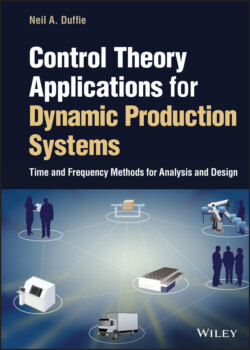Читать книгу Control Theory Applications for Dynamic Production Systems - Neil A. Duffie - Страница 20
Example 2.2 Continuous-Time Model of Backlog Regulation in the Presence of Rush Orders and Canceled Orders
ОглавлениеA continuous-time model is needed for the production system illustrated in Figure 2.3 that would facilitate design of an order release rate adjustment decision rule that tends to maintain backlog at a planned level. This type of decision-making can be referred to as backlog regulation, and it could operate manually or automatically. There are fluctuations in order input rate and disturbances in the form of rush orders and canceled orders that must be responded to by adjusting the order release rate in a manner that tends to eliminate deviations of actual backlog from planned backlog.
Figure 2.3 Backlog regulation in the presence of rush orders and canceled orders.
There are two main components: accumulation of orders in the backlog, and order release rate decision-making. The differential equation that describes backlog is similar to that developed in Example 2.1:
where wb(t) orders is the order backlog, wd(t) orders represents disturbances such as rush orders and order cancelations, ri(t) orders/day is the order input rate, and ro(t) orders/day is the order release rate.
There are many possible decision rules that can be used to implement backlog regulation. One straightforward option is to adjust the order release rate ro(t) orders/day as a function of the both difference between planned backlog and actual backlog and the integral of that difference. This decision rule is described by
or
where wp(t) orders is the planned order backlog and K1 days−1 and K2 days−2 are backlog regulation decision parameters for which values are selected that result in favorable closed-loop backlog regulation dynamic behavior. Knowledge of order input rate ri(t) orders/day and work disturbances wd(t) orders is not required in this decision rule; instead, work disturbances and fluctuations in order input rate cause backlog wb(t) orders to increase or decrease, and deviations from planned backlog wp(t) orders subsequently are responded to using the decision rule.
Combining these component models to obtain a complete system model that relates backlog to the various inputs would be straightforward in this case, but this is easily and generically done using the transformation methods described in Chapter 3. Analysis using this combined model would allow selection of a combination of values of decision rule parameters K1 and K2 that satisfy requirements for dynamic behavior such as quick return of backlog to plan after a rush order or canceled order disturbance. Other options for the form of the decision rule could result in significantly different and possibly improved regulation of backlog.
